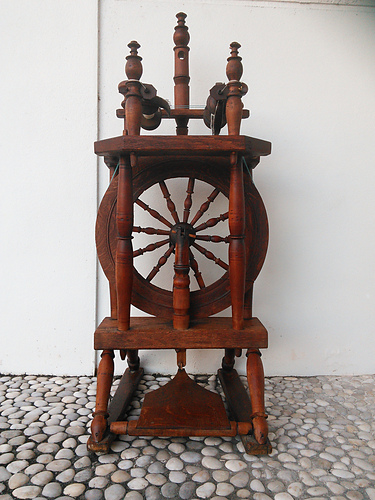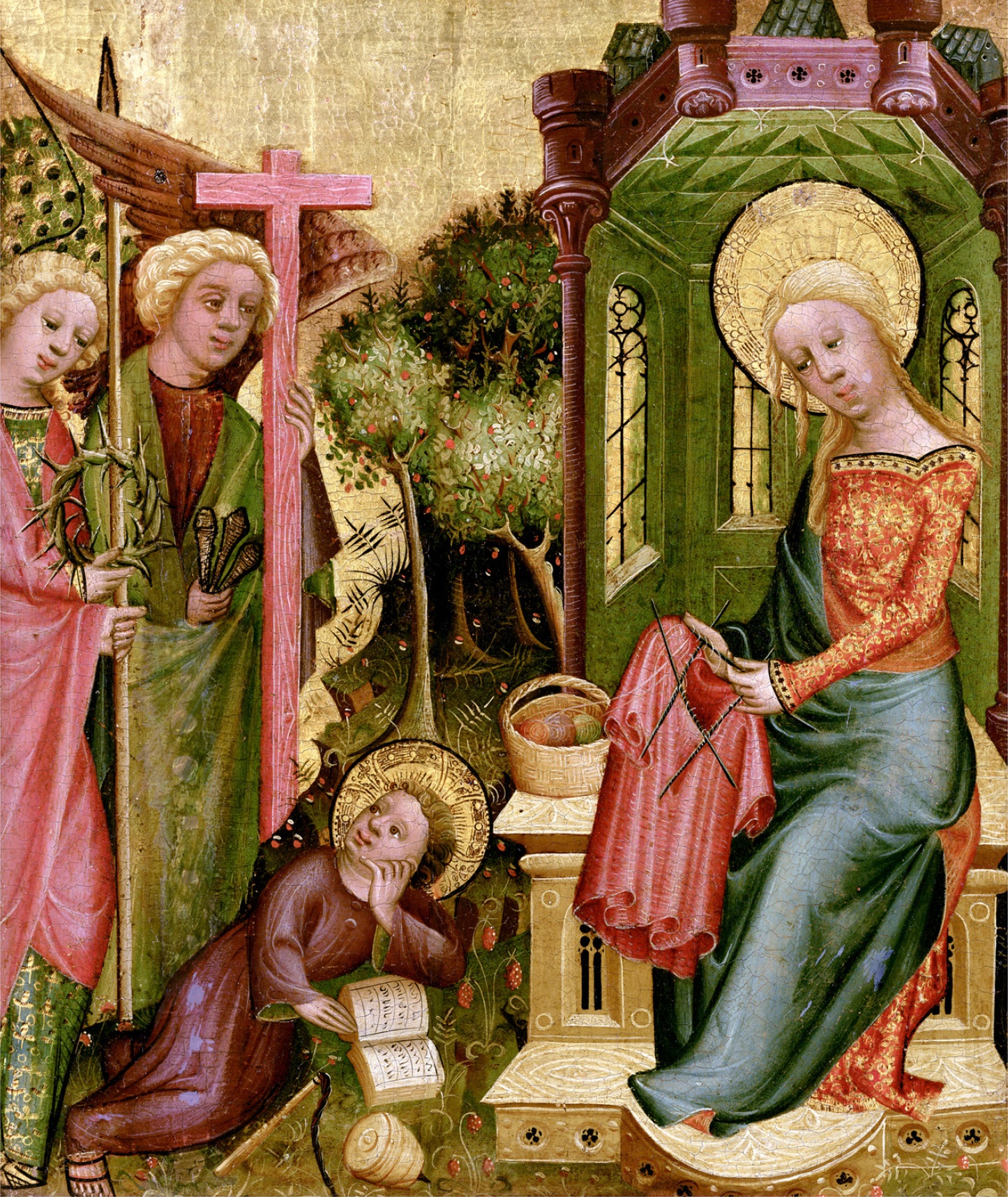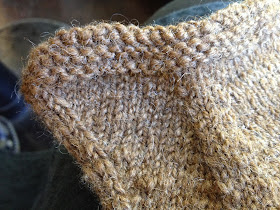
I finally did it - I knit a colorwork hat! In the round, of course, so it wasn't
maddening for me, and I really like the results. It's a simple pattern, called "From
Norway With Love", which includes a
matching mitten and scarf pattern in the download, but I just made the
hat. I used crap yarn, some cheapy
worsted Lion Brand yarn that I bought back when I was trying to teach knitting
classes at a big box store that no one ever signed up for and that the store
did little to promote. So we're not
talking high art, but the yarn is wool and has a decent hand, as crap yarn
goes, and I put some effort into choosing attractive colors when I bought
it. Frankly, as long as it isn't acrylic
babby melting extruded goo, it's hard to not be excited and see all the good
attributes when I'm buying yarn, or when I'm knitting it up. If it's total junk, I won't bother with it,
because I'm going to be spending hours with it in my hands, and then I'd like
to make something that I might be interested in wearing for a few years.
It will take some time and experience to feel okay with how
loosely I have to knit in order to not have serious draw in with all of the
floats. I have to consciously calm
myself so that I don't worry about the work looking sloppy. I still think that I go in for texture more
than color, and I'll likely still spend more time with cables and lace, but
it's a neat skill to have, and now I can knit all of those humping animals
patterns I so admire on Ravelry.
 |
| Wearing earrings I made too! |
I'm at home with a nasty cold today, and I'm spending the
day washing fleece, drinking untold cups of tea (now with whiskey...), and
studying. I have a Spanish test
tomorrow, and I'm constantly astonished by how bad I am at the language. It's unbelievably hard to make the leap from
general knowledge to some semblance of fluency.
I'm at the point where the grammar lessons are over and it's all reading
and discussion, and I'm faced with how insufficient a student vocabulary is for
reading fiction.
I'm also studying for my folklore classes, and I'm beginning
to get intimidated by an attitude I'm seeing frequently in my readings. There's a tendency to say "They didn't
address blah blah blah" when reviewing some study, film, or book about
some culture, practice, or event. It
concerns me that I'm seeing scholars assessing others' work based on what they
think should be within the scope of the project, rather than looking at it in
terms of what the authors intend to address.
My understanding about scholarly work is that, while there are sins of
omission in some cases, a large part of the preparation for a project is
determining the limits of the project, which questions it will attempt to
answer, and which ones it will not be able to address. Rarely does a project attempt to get a full
sense of every aspect of a culture or community, and those that do are unable
to go deep simply due to the constraints of space and time. One book I've been reading contained
criticisms about films made by people who were concerned with preserving
musical techniques and songs for not containing enough biographical information
about the artists. That bothers me
greatly - it wasn't the aim of the film makers to present biographies in these
very limited, short films. Any
biographical information would have taken time and space from the core
content. I have to wonder if my
fieldwork will always fall short because people will be more interested in
criticizing the scope of the work rather than viewing the content in terms of
the limits I have set. It feels like dismissing
Mondrian's paintings because they weren't photorealistic, just because you like
realism and irrespective of what the artist was trying to achieve.
The other thing I'm thinking about is how to translate my
interest in material culture - textile arts - into something that I can study
from a folkloric standpoint. The
difference seems to be context and meaning to those who are involved in the art
or craft I am studying. I'm mostly
interested in methods and materials, and the way to add the folkloric angle is
to consider the meaning behind those things to the artists and to the community
of which they are a part. I deeply enjoy
exploring those aspects, but, in all honesty, I'm more interested in the how
than the why, which is a part of my nature as a loner craftsperson and an only
child from a very small, insular family.
I've always been better at Things than People, although I like people
well enough, and I love stories.
I question whether I want to be involved in folklore as a
professional pursuit, but that has never been my motive for studying it. I am casually looking for a way to have a
steady day job that pays well, but it may or may not be integrated with the
teaching and creating that inspires me.
I imagine that I could find a position at a small museum or cultural
center, or that I could establish a fiber arts school somewhere. I would love to be involved in the textile
aspect of a living history exhibit, and it would be great if I could be a
working artist as well. I hope that my
spinning supply business will take wing, because I love wool processing,
handling wool, and helping new spinners.
Operating Lindentree Fiber Arts is like going shopping for spinning
fiber without spending money - I get to touch the wool, wash locks, look at the
pretty colors, spin samples, and sometimes spin skeins - all things that I love
more than working up the finished garments.
 |
Kindly Shetland flicked locks
Wool from Whistlestop Farm, Hillsboro, OR |
I've been reading commentaries and articles from folklorists
that refer to "preservationist" work as naïve and ignoring modern
culture as being artificial, not worth studying, and as "othering"
the cultures studied as only being interesting because they're unlike us. I understand where they're coming from, and
I saw that when I was in my previous academic life as an International
Relations major, but I disagree so
strongly. I think that modern culture IS
artificial, and, while it is worth studying, I think that we have to study it
with deep awareness of how commercial interests try to create culture and
harness the forces of informal communication and the organic spread of cultural
themes and norms. I think that we NEED
to preserve the old ways, not because they're interesting or exotic, but
because, if we don't remember them, we'll need to reinvent them when the shit hits
the fan. We need to remember how to
build our own houses, make our own tools, and entertain each other without
electricity. We need to remember our
stories and foodways, because there are lessons in them that we will NEED,
lessons that are transmitted to society at large more effectively when they
come in the form of entertainment and tradition than textbooks and scientific
papers. Yes, I am completely of the
preservationist mindset, but I don't think that there's anything exotic or
"other" about the things I want to preserve. I think that it is the one way that we can
remember who we are. I want to know what
people did right here 100 years ago, or 500 years ago. I'm interested in cultures from other
geographic places, but I'm more interested in right here, because I think that
it's important for me to know how to thrive in this particular location,
because that's where I am. I'd like to
know about the stories of my Quebecois ancestors, but I feel more pressed to
understand local herbalist traditions or how they built houses on this sodden ground.
My other concern is that since our communication systems
really started connecting large parts of the world, we have done our best to
strip away the past and reinvent ourselves.
I might look at archaeological work with interest, and I love history,
but our stories and traditions are the best way for me to connect with the
breadth of human history, and particularly the history of women and the
oppressed. I can read about Lincoln, but
how much better is it to hear the spirituals sung by enslaved peoples in the
South? Or to look at abolitionist
quilts? How interesting it is to read
recipes written for Southern white women who had never had to cook for themselves
before Emancipation, and may have been widowed as well, living for the first
time independently of servants, of slaves, and of male relatives - I get so
much more out of that than I do when I read the facts about
Reconstruction. Folklore is how the
people ignored by history get to tell their own stories, and it is how we
communicate the aspects of living that actually keep us alive in a dangerous
world. The crafts and recipes grow up in
particular locales with access to a specific set of materials and tools, and we
lose our ability to thrive in those places if we lose that knowledge, and then
we become entirely dependent on products made elsewhere and shipped in. That is worse than foolish - it's
dangerous. It completely removes our
independence.
 |
| A fine laceweight |
Right now, I seriously need some warm socks in my damp,
moderately cold environment, and I can't afford them. All of my good socks are worn thin. I can buy crappy poly or cotton socks, but
they don't do much against the damp. I'm
unemployed, and processed wool is even a bit spendy for me, and good yarn is
right out. I have tons of wool fleeces
and I can spin, so I'm in serious production mode for spinning and knitting
wool socks. Now I know that most of us
don't spin and knit for survival, but here I am, out of work and living on
loans, with more time than money, and I actually need to make socks because I
don't have them and my feet are cold and getting colder. How great is it that I know how to do this? How silly is it that most people in the U.S.
don't? And what happens if the economy
REALLY collapses? And shouldn't I know
how to make my own knitting needles and spindles? Remember how Norman Kennedy kept his family
warm during the war by gleaning wool from dead sheep- who in America knows how to do that now? When I was studying International Relations,
we talked about how refugees can be given dry goods as food aid in other countries,
but we have to get ready-to-eat rations in the affluent West - we just don't
know how to make a pot of rice. During
the recent crash, people were disseminating lessons on how to make coffee to
those who always just bought a hot cup and could no longer afford their lattes. All of this frightens me.
Not that I think that we should all be diving into crafts
out of fear, and we all know that making our own clothes is generally more
expensive than buying them readymade - if you use store-bought materials, that
is, because there are tons of cheap or free fleeces out there that need a good
amount of work in processing but can be made to work in a pinch (and the handmade things
last longer). It's amazing how easily
you can glean materials for little to nothing, if you have the time to invest
in making them into what you need. I
worry about how we have largely turned into a culture that does not know how to
repair, repurpose, and create, and I know that much of what I know about
textile arts still exists because a few people have preserved the old ways
during periods of time when society looked down on their practice and did its
best to forget. We've seen that story
with sheep breeds, and with heirloom seeds - so often, a breed is almost lost,
but one or two farmers stubbornly continue to work with it, and so we have it
today. Another criticism of
preservationists is that they sometimes romanticize their subjects - but hello,
how is this not romantic? The one person
standing between an ancient tradition and oblivion is a romantic figure by any
definition. If we don't recognize the
romance in these things, we remove an important part of their significance. This is also why we say that we "fall in love" with spinning, knitting, weaving, tatting, etc. - there IS romance there, right alongside history, hard work, and hard-won skills.
 |
| Fne Shetland yarn on the Vezina Canadian Production Wheel |
I can't forget my humanity, and I don't want to. I think that the voice of the author is just
as important as the content, even in academic work, and it should be - it is
one of the ways that a dry subject can feel relevant to the audience. I want my work to inspire people to want to
preserve and carry on the old ways, to keep them alive in a real and meaningful
way that contributes to our well-being - or even survival - as a species. And yes, it can be frustrating when people
make comments about us spinners and weavers keeping the craft alive, as though
there aren't tons and tons of us doing it all of the time, but there are lots of dusty corners of the
textile world that really do need our attention to keep them from dying
out. How many of us actively and
frequently spin on a great wheel? Do
Chilkat weaving? Maintain an old-school
indigo bath? Fix antique spinning
wheels, or make them by hand? I don't
know the answer, but there are WAY fewer of us doing these things than spinning
commercial top on modern spinning wheels or using indie dyed merino yarns to knit Ysolda Teague patterns, and even fewer who have developed sufficient
expertise to teach or write about these practices - which is what really keeps
the arts alive.
(By the way, Ysolda rocks, and there's nothing wrong with knitting or spinning any particular way - whatever makes you happy, and the world smiles a little whenever someone turns time into warmth, but I say these things just to point out that there are subgroups of subgroups. Where villages used to devote time to a particular craft, now there are 200 people doing it, few of whom live close enough to each other to interact face to face, and that isn't exactly a recipe for a long-lasting, vibrant art form. Now if three of those people decide to dedicate some energy to teaching their craft, it can make a huge difference in its future.)
I guess I'm different from most of the others in my classes
in that I'm interested in learning about cultural practices in order to
practice them myself. I think that
actively maintaining our human traditions is a personal responsibility in a
time when commerce seeks to homogenize culture and determine our practices and
needs through advertising. I think that
simply recording my findings is insufficient, although it is important too, as
it can be one of the ways that the next generation finds what it needs. I think that it is dangerous to move through
the world as if we don't need to know who we are or how to create the things we
consider essential for a good life. I
think that we all need to take an interest in the past and try to remember how
to be self-sufficient, and to do these things in joy, and beauty, and love,
honoring our connections and celebrating our clever hands. Let us also create things that those who come
later will strive to preserve.

















































